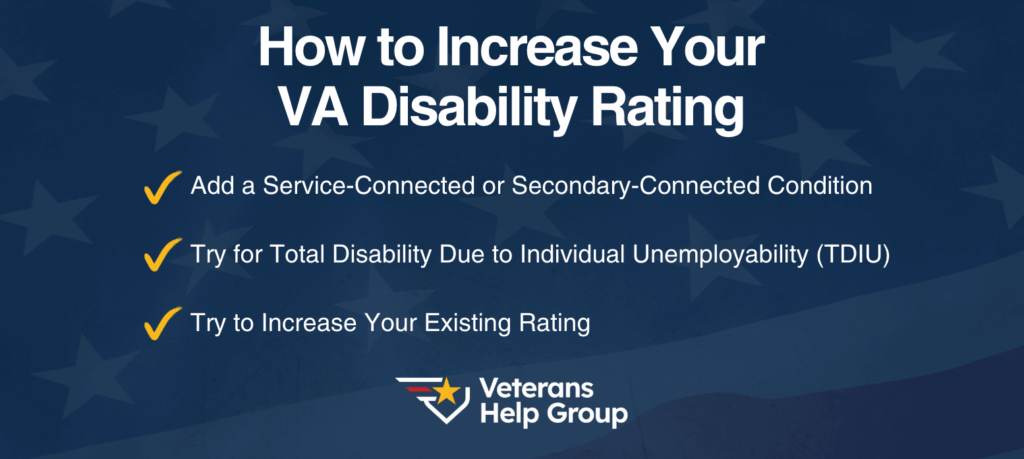
Table Of Contents
Increasing Your VA Disability Rating from 90% to 100%
A 90% disability rating sounds good. In 2025, a 90% rating will get a veteran with no dependents $2,297.96/month in veterans disability benefits and access to medical care. However, the difference in benefits at a 90% disability rating and benefits at a 100% disability rating are significant.
For instance, the monthly benefit at 100% is $3,831.30. That’s a difference of over $1,500/month. Additional benefits, such as dependent healthcare coverage, may also be available at the 100% rating level.
It’s beneficial to push a 90% rating to a 100% rating if you’re able. But, how can you make that happen?

How to Increase Your VA Disability Rating
The best approach for trying to increase your disability rating from 90% to 100% will depend on your circumstances.
Factors like the severity of your current conditions, whether your symptoms have worsened, or if you’ve developed new service-connected issues can all play a role. Some veterans may benefit from filing for a rating increase on an existing condition, while others might have better luck adding a new secondary condition or applying for TDIU. Knowing your options and the pros and cons of each is key to a successful claim.
Add a Service-Connected or Secondary-Connected Condition
If you have another chronic medical condition that you believe is service-connected, or your service-connected condition has caused another condition, you may be able to increase your VA disability rating by adding that claim. Know, though, that the way the VA calculates combined ratings isn’t as simple as adding the ratings together. The higher the disability rating for your existing condition is, the harder it is to move up by adding a condition.
At the 90% level, a single additional condition would have to be rated at 50% or higher to get you to 100%.
Try for Total Disability Due to Individual Unemployability (TDIU)
A veteran who is classified as TDIU can receive benefits at the 100% level, even though their actual rating is lower. This rating is available only to veterans who are unable to work steadily due to a service-connected condition. In most cases, the veteran will need either a 60% disability rating for a single condition or a 70% combined rating with one condition rated at 40%. However, in limited circumstances an extra-schedular TDIU designation is possible.
Try to Increase Your Existing Rating
If you think your initial rating was too low, your service-connected medical condition has gotten worse or the VA’s standards for your condition have changed, you may be able to increase your existing rating. Note, though, that when you open the door to reassessing your rating, the VA can adjust your rating in either direction. In other words, you could end up with a lower rating. So, it’s important to make sure the evidence is on your side.
Thinking About Appealing for a Higher VA Rating? Here’s What to Watch Out For
Going from a 90% to a 100% VA rating can mean big benefits, but before you jump in, it’s worth knowing a few potential drawbacks.
1. It can take a while.
Appeals aren’t speedy. With the VA dealing with hundreds of thousands of backlogged cases at times, your appeal might sit in the queue for months before anything happens. Be patient during this process.
2. Surprise exams might pop up.
Even if you technically qualify to skip additional exams, the VA might still call you in for one. It doesn’t always make sense, but it happens
3. Your current rating could be at risk.
When you appeal, the VA takes another look at your entire file. That means they could decide to lower your rating instead of raising it. It doesn’t happen to everyone, but it’s a real risk.
If you’re thinking about appealing, it’s smart to weigh the pros and cons and get expert guidance from a VA-accredited advocate before moving forward.
Choosing the Best Path to a 100% Disability Rating for You
The best way to determine whether and how you should pursue an increase in your veterans disability benefits is to get knowledgeable guidance from an experienced disability benefits advocate. At Veterans Help Group, we understand the process and what the VA will be looking for with each type of claim. To learn more about how we can help, call (855) 855-8992 or fill out our contact form here.
Read More About This Topic:
- HOW TO INCREASE YOUR VA DISABILITY RATING FROM 80% TO 100%
- PTSD AND VETERANS: UNDERSTANDING THE 100% DISABILITY RATING REQUIREMENTS
- DIFFERENT TYPES OF 100% VA DISABILITY RATINGS
- THE DIFFERENCE BETWEEN 100% FOR UNEMPLOYABILITY AND 100% DISABILITY RATING
- 50% VA DISABILITY RATING EXPLAINED
- WHAT DOES IT MEAN TO HAVE A 100% VA DISABILITY RATING?
- WHAT BENEFITS DOES A 60% VA DISABILITY RATING GET?

VA Disability Benefits and Tax Exemptions: What You Should Know
VA Disability Benefits and Tax Exemptions: What You Should Know Written by: Schuyler Swanton,...

Veterans Help Group In The Community
Veterans Help Group in the Community Written by: Bobbi Boudi, Director of Community Outreach, Amy...

The Veterans Appeals Efficiency Act of 2025
The Veterans Appeals Efficiency Act of 2025 Several bills are currently pending in Congress that...





